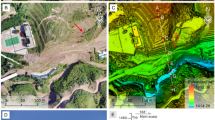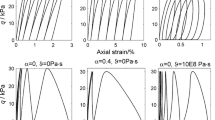Abstract
Flow-like landslides in clayey soils represent serious threats for populations and infrastructures and have been the subject of numerous studies in the past decade. However, despite the rising need for landslide mitigation with growing urbanization, the transient mechanisms involved in the solid-fluid transition are still poorly understood. One way of characterizing the solid-fluid transition is to carry out rheometrical tests on clayey soil samples to assess the evolution of viscosity with the shear stress. In this study, we carried out geotechnical and rheometrical tests on clayey samples collected from six flow-like landslides in order to assess if these clayey soils exhibit similar characteristics when they fluidize (solid-fluid transition). The results show that (1) all tested soils except one exhibit a yield-stress fluid behavior that can be associated with a bifurcation in viscosity (described by the critical shear rate \( \dot{\gamma_c} \)) and in shear modulus G; (2) the larger the amplitude of the viscosity bifurcation, the larger the associated drop in G; and (3) the water content (w) deviation from the Atterberg liquid limit (LL) seem a key parameter controlling a common mechanical behavior of these soils at the solid-fluid transition. We propose exponential laws describing the evolution of the critical shear stress τc, the critical shear rate \( \dot{\gamma_c} \), and the shear modulus G as a function of the deviation w-LL.







Similar content being viewed by others
References
Ancey C (2007) Plasticity and geophysical flows: a review. J Non-Newtonian Fluid Mech 142(13):4–35
Ancey C, Jorrot H (2001) Yield stress for particle suspensions within a clay dispersion. J Rheol 45(2):297–319
Bardou E, Bowen P, Boivin P, Banfill P (2007) Impact of small amounts of swelling clays on the physical properties of debris-flow-like granular materials. Implications for the study of alpine debris flow. Earth Surf Process Landf 32(5):698–710
Bièvre G, Jongmans D, Winiarski T, Zumbo V (2011) Application of geophysical measurements for assessing the role of fissures in water infiltration within a clay landslide (Trièves area, French Alps). Hydrol Process 26(14):2128–2142
Bird RB, Armstrong RC, Hassager O (1987) Dynamics of polymeric liquids, vol 1. John Wiley and Sons, New York
Bonn D, Paredes J, Denn MM, Berthier L, Divoux T, Manneville S (2015) Yield stress materials in soft condensed matter. Rev Mod Phys
Boyer F, Guazzelli E, Pouliquen O (2011) Unifying suspension and granular rheology. Phys Rev Lett 107:188301
Chambers JE, Wilkinson PB, Kuras O, Ford JR, Gunn DA, Meldrum PI, Pennington CVL, Weller AL, Hobbs PRN, Ogilvy RD (2011) Three-dimensional geophysical anatomy of an active landslide in Lias Group mudrocks, Cleveland Basin, UK. Geomorphology 125(4):472–484
Coussot P (1995) Structural similarity and transition from Newtonian to non-Newtonian behavior for clay-water suspensions. Phys Rev Lett 74:3971–3974
Coussot P (2005) Rheometry of pastes, suspensions, and granular materials, Wiley Online Library
Coussot P, Ancey C (1999) Rheophysical classification of concentrated suspensions and granular pastes. Phys Rev E 59:4445–4457
Coussot P, Piau JM (1994) On the behavior of fine mud suspensions. Rheol Acta 33(3):175–184
Coussot P, Laigle D, Arattano M, Deganutti A, Marchi L (1998) Direct determination of rheological characteristics of debris flow. J Hydraul Eng 124(8):865–868
Coussot P, Nguyen QD, Huynh HT, Bonn D (2002a) Viscosity bifurcation in thixotropic, yielding fluids. J Rheol 46(3):573–589
Coussot, P.; Nguyen, Q. D.; Huynh, H. T. & Bonn, D. (2002b) Avalanche behavior in yield stress fluids. Phys Rev Lett 88 - Number 17–5501, 4p
Dagois-Bohy S, Hormozi S, Guazzelli E, Pouliquen O (2015) Rheology of dense suspensions of non-colloidal spheres in yield-stress fluids. J Fluid Mech 776
Farrar DM, Coleman JD (1967) The correlation of surface area with other properties of nineteen British clay soil. J Soil Sci 18(1):118–124
Haigh SK (2012) Mechanics of the Casagrande liquid limit test. Can Geotech J 49(9):1015–1023
Hungr O, Leroueil S, Picarelli L (2014) The Varnes classification of landslide types, an update. Landslides 11(2):167–194
Huynh HT, Roussel N, Coussot P (2005) Aging and free surface flow of a thixotropic fluid. Phys Fluids 17:033101
Imran J, Harff P, Parker G (2001) A numerical model of submarine debris flow with graphical user interface. Comput Geosci 27(6):717–729
Iverson RM (1997) The physics of debris flows. Rev Geophys 35(3):245–296
Iverson RM (2005) Regulation of landslide motion by dilatancy and pore pressure feedback. J Geophys Res: Earth Surf 110(F2)
Iverson RM, George DL (2016) Modelling landslide liquefaction, mobility bifurcation and the dynamics of the 2014 Oso disaster. Géotechnique 66(3):175–187
Jaboyedoff, M.; Pedrazzini, A.; Loye, A.; Oppikofer, T.; i Pons, M. G. & Locat, J.Malet, J.-P.; Remaitre, A. & Bogaard, T., ed. (2009), Earth flow in a complex geological environment: the example of Pont Bourquin, Les Diablerets (Western Switzerland), Landslide Processes, From Geomorphologic Mapping to Dynamic Modelling
Jeong SW, Locat J, Leroueil S, Malet J-P (2010) Rheological properties of fine-grained sediment: the roles of texture and mineralogy. Can Geotech J 47(10):1085–1100
Jeong SW, Locat J, Leroueil S, Malet J-P (2012) The effects of salinity and shear history on the rheological characteristics of illite rich clays. Clay Clay Miner 60:108–120
Khaldoun A, Moller P, Fall A, Wegdam G, De Leeuw B, Méheust Y, Fossum J, Bonn D (2009) Quick clay and landslides of clayey soils. Phys Rev Lett 103:188301
Locat J (1997) Normalized rheological behavior of fine muds and their flow properties in a pseudoplastic regime', Debris-flow hazards mitigation: mechanics prediction and assessment, Water Ressources Engineering Division. Am Soc Civil Eng 260–269
Locat J, Demers D (1988) Viscosity, yield stress, remolded strength, and liquidity index relationships for sensitive clays. Can Geotech J 25(4):799–806
Mackey BH, Roering JJ, McKean JA (2009) Long-term kinematics and sediment flux of an active earthflow, Eel River, California. Geology 37(9):803–806
Mainsant G, Jongmans D, Chambon G, Larose E, Baillet L (2012a) Shear-wave velocity as an indicator for rheological changes in clay materials: lessons from laboratory experiments. Geophys Res Lett 39(19), 5p
Mainsant G, Larose E, Brönnimann C, Jongmans D, Michoud C, Jaboyedoff M (2012b) Ambient seismic noise monitoring of a clay landslide: toward failure prediction. J Geophys Res: Earth Surf 117(F1)
Mainsant G, Chambon G, Jongmans D, Larose E, Baillet L (2015) Shear-wave-velocity drop prior to clayey mass movement in laboratory flume experiments. Eng Geol 192:26–32
Maio C, Scaringi G (2016) Shear displacements induced by decrease in pore solution concentration on a pre-existing slip surface. Eng Geol 200:1–9
Malet J-P, Remaître A, Maquaire O, Ancey C, Locat J (2003) Flow susceptibility of heterogeneous marly formations. Implications for torrent hazard control in the Barcelonnette basin (Alpes-de-Haute-Provence, France), in D. Rickenmann & C.-L. (Eds) Chen, ed., 'Third International Conference on Debris-Flow Hazard Mitigation: Mechanics, Prediction and Assessment', Millpress, Rotterdam, Davos, Switzerland, 351–362
Malet J-P, Maquaire O, Remaître A (2004) Assessing debris flow hazards associated with slow moving landslides: methodology and numerical analyses. Landslides 1:83–90
Malet J-P, Laigle D, Remaître A, Maquaire O (2005) Triggering conditions and mobility of debris flows associated to complex earthflows. Geomorphology 66:215–235
Maquaire O, Malet J-P, Remaître A, Locat J, Klotz S, Guillon J (2003) Instability conditions of marly hillslopes: towards landsliding or gullying? The case of the Barcelonnette basin, South East France. Eng Geol 70(1–2):109–130
Mitchell JK (1993) Fundamentals of soil behavior, second edition, Wiley
Ovarlez G, Mahaut F, Deboeuf S, Lenoir N, Hormozi S, Chateau X (2015) Flows of suspensions of particles in yield stress fluids. J Rheol 59(6):1449–1486
Picarelli L, Urciuoli G, Russo C (2004) Effect of groundwater regime on the behaviour of clayey slopes. Can Geotech J 41(3):467–484
Picarelli L, Urciuoli G, Ramondini M, Comegna L (2005) Main features of mudslides in tectonised highly fissured clay shales. Landslides 2(1):15–30
Renalier F, Bièvre G, Jongmans D, Campillo M, Bard PY, Miller RD, Bradford JH, Holliger K, ed. (2010) Clayey landslide investigations using active and passive VS measurements, Vol. 15, Advances in Near-Surface Seismology and Ground-Penetrating Radar, Geophysical Dev. Series
Rickenmann D, Laigle D, McArdell BW, Hubl J (2006) Comparison of 2D debris-flow simulation models with field events. Comput Geosci 10:241–264
Santamarina JC, Klein KA, Wang YH, Prencke E (2002) Specific surface: determination and relevance. Can Geotech J 39:233–241
Sridharan A, Prakash K (2000) Percussion and cone methods of determining the liquid limit of soils: controlling mechanisms. Geotech Test J 23:236–244
Trulsson M, Bouzid M, Kurchan J, Clément E, Claudin P, Andreotti B (2015) Athermal analogue of sheared dense Brownian suspensions. Europhys Lett 111:18001
van Asch TWJ, Malet J-P (2009) Flow-type failures in fine-grained soils: an important aspect in landslide hazard analysis. Nat Hazards Earth Syst Sci 9(5):1703–1711
Yukselen Y, Kaya A (2006) Prediction of cation exchange capacity from soil index properties. Clay Miner 41:827–837
Acknowledgements
The authors thank Frédéric Ousset and Hervé Bellot from IRSTEA (rheometrical tests) and Martine Lanson and Nathaniel Findling from ISTerre (geochemical and mineralogical analyses) for their assistance. The authors acknowledge financial support from the French VOR federative structure, the ARC project from the Rhônes-Alpes region (France), and the CNRS through the INSU-TS-aléas program.
Author information
Authors and Affiliations
Corresponding authors
Electronic supplementary material
ESM 1
(PD950 kb)
Appendices
Appendix 1
Appendix 2. Back-analysis of Pont-Bourquin debris flow event
The Bing software (Imran et al. 2001) solves a 1D shallow-flow model relying on a viscoplastic rheology (Bingham or Herschel Bulkley) to simulate the propagation of debris flows. It has been initially developed for submarine debris flows, but can be adapted to subaerial flows by using an ambient fluid density equivalent to the air (1 kg m−3). The computation of the flow starts from a semi-parabolic mass defined by a length and a thickness. The flow then propagates on an altimetric profile which is provided by the user.
Similar to Malet et al. (2004), we used this software to carry out a back-analysis of a debris flow event that occurred on the PO landslide in summer 2007 and was documented by Jaboyedoff et al. (2009). After heavy rainfalls, a flowing volume of about 11,000 m3 cut the road at the toe of the landslide. A detailed geomorphological analysis provided the necessary information regarding the localization and size of the initial unstable mass. Accordingly, a maximum thickness of 3 m and a length of 100 m were used as initial conditions in Bing. Field observations after the event indicated a length of propagation of 130 to 160 m, and a front thickness of approximately 2 m on the road. In agreement with recommendations of Imran et al. (2001), numerical parameters were taken as follows: artificial viscosity = 10−4; number of nodes in domain = 21; time step = 10−5 min. A Herschel-Bulkley viscoplastic law with an exponent n = 0.25 was used. In agreement with the common practice for muddy debris flows (Coussot et al. 1998; Rickenmann et al. 2006), the ratio τc/K between the critical stress τc and consistency K the material was considered constant, with values in the range 3–5 s−n. Figure 8 shows the evolution of flow runout as a function of the considered critical shear stress and ratio τc/K. All the simulated-flows shown in Fig. 8 present front thicknesses between 1 and 2 m, in agreement with field values. It is observed that the simulated runout significantly decreases with the ratio τc/K. Depending on the value of this ratio, values of critical shear stress τc lying between 550 and 1300 Pa are necessary to reproduce the runout of the 2007 event.
Rights and permissions
About this article
Cite this article
Carrière, S.R., Jongmans, D., Chambon, G. et al. Rheological properties of clayey soils originating from flow-like landslides. Landslides 15, 1615–1630 (2018). https://doi.org/10.1007/s10346-018-0972-6
Received:
Accepted:
Published:
Issue Date:
DOI: https://doi.org/10.1007/s10346-018-0972-6





